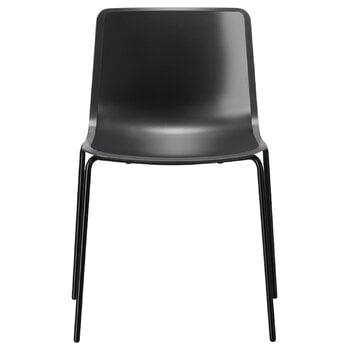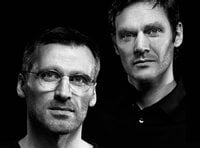Fredericia's Pato chair is a member of a versatile chair collection designed by Welling/Ludvik. Pato chairs feature comfortably shaped polypropylene seats with different base materials and structures. The collection is based on Fredericia's long traditions of craftsmanship and finished with modern techniques and eco-friendly, recyclable materials. Pato chairs were released in 2013 after three years of development. The chairs are built in Fredericia's own factory in Denmark, and they have been tested for durability at the Danish Technological Institute, where they passed the highest level, making them suitable for hard use in public spaces. The attractive silhouettes and beautiful finishes make the Pato chairs perfect for modern homes, too.
Pato chair, 4 legs, black
Fredericia
Description
Fredericia's Pato chair is a member of a versatile chair collection designed by Welling/Ludvik. Pato chairs feature comfortably shaped polypropylene seats with different base materials and structures. The collection is based on Fredericia's long traditions of craftsmanship and finished with modern techniques and eco-friendly, recyclable materials. Pato chairs were released in 2013 after three years of development. The chairs are built in Fredericia's own factory in Denmark, and they have been tested for durability at the Danish Technological Institute, where they passed the highest level, making them suitable for hard use in public spaces. The attractive silhouettes and beautiful finishes make the Pato chairs perfect for modern homes, too.
Product details (9)
- Colour
- Black
- Width
- 21.65 in (55 cm)
- Depth
- 20.47 in (52 cm)
- Height
- 31.1 in (79 cm)
- Seat height
- 18.31 in (46.5 cm)
- Frame material
- Steel
- Seat material
- Polypropylene
- Weight
- 11.9 lbs (5.4 kg)
- Warranty
- 7 years
- Product ID
Designer
Design duo Welling/Ludvik was founded in 2010 by the Danish designer Hee Welling and Icelandic designer Gudmundur Ludvik, both former students of the Danish Design School. Welling/Ludvik aims at renewing Scandinavian design traditions by focusing on functional esthetics, personal experience and environmentally friendly production. The duo has contributed to modern Scandinavian design with new, interesting combinations of forms, materials and atmospheres.
View all productsReviews (0)
Sustainability
The Product Sustainability Framework, our criteria of sustainable design, helps you find the most sustainable products in our selection. Read below which sustainability criteria this product has met.
Working conditions & labour 7/9
-
Equal opportunities for all employees
-
Commitment to UN Global Compact, fair compensation for all employees
-
Corporate responsibility requirements defined and communicated for suppliers
-
Systematic work for improved inclusion and well-being in the workplace
-
Transparent supply chain
-
Suppliers' compliance to a code of conduct ensured
-
Support for community involvement in the supply chain
-
Direct suppliers audited and certified
-
Compliance to the UN Guiding Principles on Business and Human Rights ensured in the supply chain
Eco-friendly production 6/9
-
Fair and resource-wise water-use in production
-
No incineration or landfilling of returned items
-
No use of endangered species as materials
-
No direct environmental emissions or waste (excl. GHGs) from production
-
Material-efficient and ecological packaging
-
No potentially harmful chemicals used in own production
-
The sustainability of direct suppliers' production is addressed and monitored
-
Production and material sourcing that respect biodiversity, animal rights, and natural ecosystems
-
Positive impact on nature’s well-being through operations that regenerate natural ecosystems
Climate impact 5/8
-
Company's direct greenhouse gas emissions identified and commitment to reduction
-
Product's carbon impact identified and commitment to reduction
-
Guidance on energy- and eco-efficient use of the product
-
Contribution to climate initiatives beyond the brand’s direct operations
-
Carbon footprint of the product calculated and goals set to reduce it
-
Low-carbon or compensated transportation
-
100 % renewable energy in own production and operations
-
Carbon neutral or carbon negative product
Sustainable materials 5/6
-
Sustainable and long-lasting material choices
-
No harmful or hazardous substances
-
Responsible raw material sourcing and production
-
Materials suited for circularity: monomaterials, recyclable finishings, renewable or recycled contents etc.
-
Ecological materials: natural, biodegradable, recyclable or recycled contents
-
Outstanding materials in terms of innovativeness, responsibility, sustainability and circularity: local production or sourcing, 100 % recycled content, C2C-certification etc.
Circular design 4/5
-
High aesthetic quality promoting long-term use of the product
-
Technically durable product design and material choices
-
Design for enduring life-long quality
-
Design and support for product maintenance, repair and upgradability
-
Innovative circular design solutions: circular service system, resale platform, remanufacturing, collection of used products, etc.






